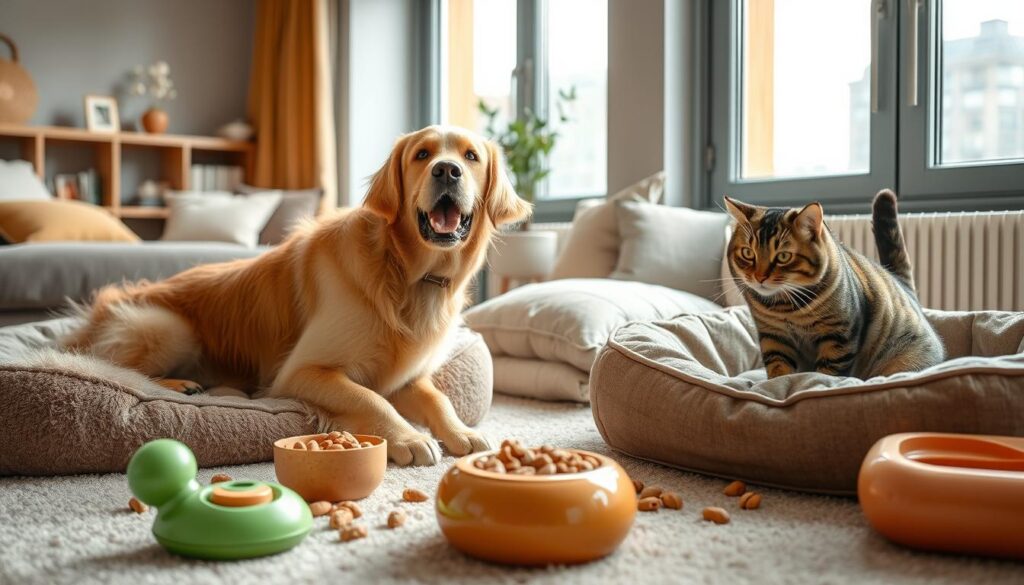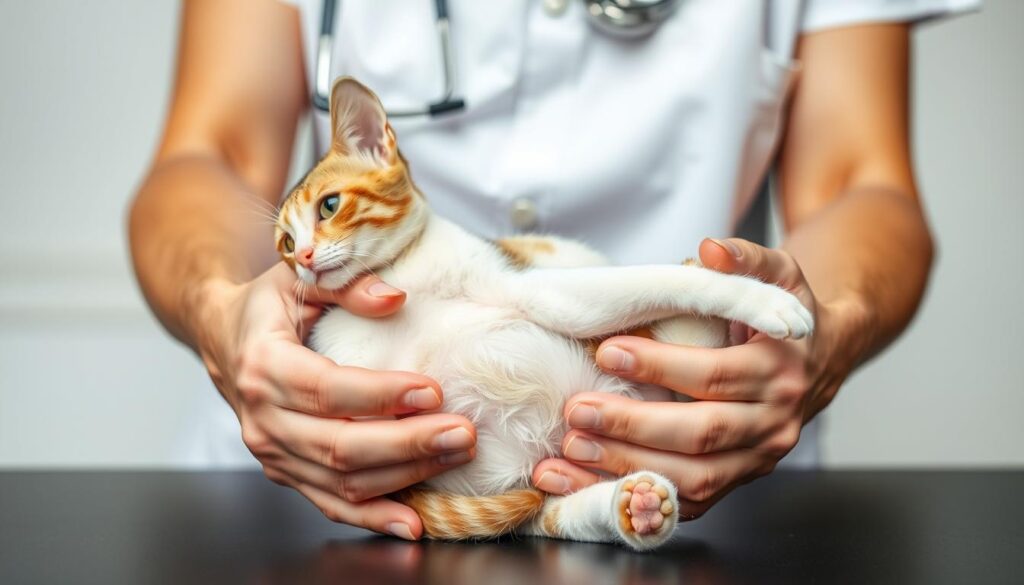Managing Weight Gain in Apartment Pets

As a pet owner living in an apartment, you face unique challenges in maintaining your pet's health and weight. With nearly 60% of dogs and cats in the United States classified as overweight or obese, it's a growing concern that requires attention.
The confined environment of apartment living can limit exercise opportunities, contributing to weight gain. Recognizing the signs of unhealthy weight gain in your pet is crucial. By understanding the impact of your living situation on your pet's health, you can take practical steps to maintain a healthy weight and improve their overall health.
By adopting a balanced approach to diet, exercise, and mental stimulation tailored to apartment living, you can help extend your pet's life and enhance their quality of life.
The Growing Problem of Pet Obesity
With nearly 60% of dogs and cats classified as overweight or obese, pet obesity is a serious issue. As a result, it's essential to understand the scope of this problem and its impact on your pet's health.
Understanding the Pet Obesity Epidemic
The pet obesity epidemic affects more than 50 million dogs and 56 million cats nationwide, with numbers increasing since 2010. This growing problem is not just a cosmetic issue; it's a medical condition that requires attention and action from pet owners.
Some key statistics highlighting the pet obesity epidemic include:
- Nearly 60% of dogs and cats in the United States are classified as overweight or obese.
- Over 50 million dogs and 56 million cats nationwide are affected.
- The numbers have been increasing since 2010.
Health Risks Associated with Overweight Pets
Excess fat tissue creates an unhealthy, chronically inflamed internal environment, weakening your pet's immune system and increasing the risk for serious health issues. Obese pets can experience endocrine abnormalities, leading to conditions like diabetes mellitus, thyroid dysfunction, and Cushing's disease.
| Health Risks | Description |
|---|---|
| Diabetes | A condition where the body doesn't produce enough insulin, leading to high blood sugar levels. |
| Osteoarthritis | A degenerative joint disease causing pain and stiffness in the joints. |
| Heart Disease | A condition affecting the heart's ability to function properly, potentially leading to heart failure. |

By understanding the risks associated with pet obesity, you can take proactive steps to manage your pet's weight and improve their overall health.
Recognizing Weight Issues in Your Apartment Pet
Recognizing weight issues in your apartment pet is the first step towards ensuring their overall health and wellbeing. Many pet owners are unaware of the signs of pet obesity, which can lead to serious health problems.
How to Assess Your Pet's Body Condition
To assess your pet's body condition, start by feeling their ribs. Place your hands flat on either side of their rib cage; you should be able to easily feel their ribs without pressing hard. When viewed from above, your pet should have a clearly defined waist between the last rib and the hip bones. Additionally, when standing naturally, there should be an upward curve along their underline, from the last rib to the groin.

Breeds and Factors That Increase Obesity Risk
Certain breeds are more prone to obesity. For dogs, breeds like Labrador retrievers, pugs, and Cavalier King Charles spaniels have a higher risk of weight gain. For cats, mixed-breed cats tend to gain weight more easily than purebred cats. Additionally, living in an apartment can contribute to pet obesity due to limited space for exercise and the tendency to compensate with extra treats or food.
It's also important to consider other factors that may contribute to weight gain in your pet, such as pre-existing injuries or medical conditions that limit mobility. Regular weight assessments are crucial for apartment pets, as gradual weight changes can be difficult to notice. By understanding your pet's normal body condition, you can identify concerning changes in weight or behavior before they develop into more serious health issues.
Tackling Pet Obesity in Apartment Living
The challenge of pet obesity in apartment living can be effectively addressed through a comprehensive plan that encompasses diet management, exercise, and mental stimulation. As an apartment dweller, you have a unique set of challenges when it comes to managing your pet's weight. However, with the right strategies, you can help your pet achieve a healthy weight and improve their overall quality of life.
Diet Management Strategies for Limited Spaces
Managing your pet's diet is crucial in tackling obesity. To start, you should measure your pet's food portions precisely to avoid overfeeding. Selecting low-calorie foods that are nutrient-rich is also essential. Establishing a consistent feeding schedule helps regulate your pet's metabolism and prevents unnecessary snacking. It's also important to show affection to your pet through means other than food, such as interactive play or grooming sessions.
Here's a simple table to help you track your pet's daily food intake and exercise routine:
| Time of Day | Food/Activity | Calories/Intensity |
|---|---|---|
| Morning | Breakfast | 200 calories |
| Afternoon | Playtime | Moderate |
| Evening | Dinner | 250 calories |
Creative Exercise Solutions for Apartment Pets
Despite the limited space, you can create effective exercise opportunities for your apartment pet. Interactive toys and obstacle courses made from household items can keep your pet active. Designating play zones within your apartment can also maximize the available space. Taking advantage of vertical space by adding cat trees or shelves can significantly increase your pet's activity level. Short, frequent exercise sessions throughout the day can be more effective than longer workouts.
Mental Stimulation to Prevent Boredom Eating
Mental stimulation is crucial for preventing boredom eating in apartment pets. Puzzle feeders, training sessions, and rotating toys can keep your pet's mind engaged and reduce food-seeking behavior. Establishing a consistent daily routine that includes scheduled exercise, feeding times, and play sessions helps create structure and predictability, aiding in weight management.
By implementing these strategies, you can help your pet maintain a healthy weight and improve their overall health and wellbeing.
Creating a Sustainable Weight Management Plan
Creating a sustainable weight management plan for your apartment pet requires a multi-faceted approach. To achieve this, you should partner with yourveterinarianto create a customized plan that accounts for your pet's specificbreed, age, and existinghealth conditions.
Your pet's weight loss journey should begin with a visit to the veterinarian to assess their overall health and identify the underlying causes of their obesity. A balanced diet and regular exercise are crucial elements of a successful weight management plan.
Sustainable weight management requires consistent monitoring of your pet's progress through regular weigh-ins and body condition assessments. This allows you to make necessary adjustments to their diet and exercise routine. It's essential to involve all household members in your pet's weight management plan to ensure everyone is on the same page.
Celebrating small victories along the way can help maintain your motivation and reinforce the positive changes you're making to improve your pet's quality of life. As your pet ages or if their health conditions change, you'll need to adapt their weight management plan accordingly, working closely with your veterinarian.
Remember, maintaining your pet's healthy weight is a lifelong commitment that will significantly improve their quality of life, potentially adding years to their lifespan and reducing veterinary costs associated with obesity-related conditions.

Leave a Reply